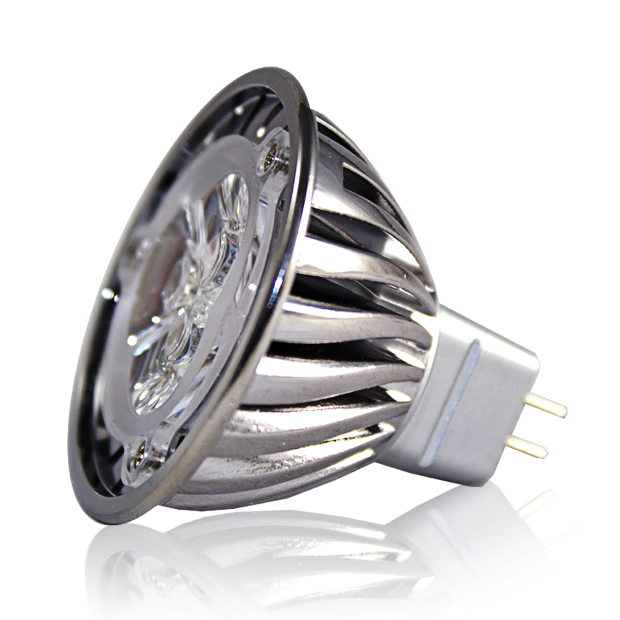An Introduction To LED MR16 Light Bulbs
Posted by Amit Soni on 19th Mar 2012

The Multifaceted Reflector (MR) light bulb is a design that houses LEDs (Light-Emitting Diodes). Whilst the format has been around for quite a while and was used initially for halogen bulbs, it really began to take off following the introduction of low-voltage LED lighting.
MR16 Bulbs The Story So Far
The MR16 format itself was originally sold in the US in 1965, after a patent was awarded to Emmett H. Wiley of General Electric, and it was used primarily in slide projectors, later becoming prevalent in both domestic and commercial settings.
A particularly versatile bulb, the LED MR16 Bulb has expanded its range of applications over the years, and they’re now widely installed in locations that require directional lighting such as desk lamps, pendant fixtures, track lighting, recessed ceiling lights, landscape lighting and bicycle lighting, as well as in retail displays.
Specifications
The “16” of its title refers to the bulb’s diameter which is 16 eighths of an inch or 51mm, meaning the beam angle is quite narrow. The small internal mirrors which typify the MR16’s design, serve to focus the bulb’s beam, making it the ideal spot and feature light bulb, and goes some way towards explaining its popularity.
All LED MR16 bulbs utilise the ANSI (American National Standards Institute) standard GU5.3 two-pin base configuration, which consists of two straight metal pins that slot directly into a holder without the need to twist.
For the technically-minded, the following ANSI standard codes are used to designate certain power and beam angle combinations for MR16 lamps.
| ANSI code | Power (W) | Beam angle | Designation |
| ESX | 20 | 10° | 20MR16/10° |
| BAB | 20 | 35° | 20MR16/40° |
| EXT | 50 | 15° | 50MR16/15° |
| EXZ | 50 | 25° | 50MR16/25° |
| EXN | 50 | 40° | 50MR16/40° |
| FNV | 50 | 60° | 50MR16/60° |
| FPA | 65 | 15° | 65MR16/15° |
| FPC | 65 | 25° | 65MR16/25° |
| FPB | 65 | 40° | 65MR16/40° |
| EYF | 75 | 15° | 75MR16/15° |
| EYJ | 75 | 25° | 75MR16/25° |
| EYC | 75 | 40° | 75MR16/40° |
LED MR16 bulbs have a very low operating voltage, which, at 12 volts is substantially lower than the UK standard 230 volt mains voltage, therefore they rely on a transformer or ‘driver’ to function correctly.
Either ferromagnetic or electronic, this is designed to ‘step down’ the mains voltage to a usable level and is usually housed separately, most often to be found in the space above your ceiling, but integrated drivers are also available.
A Huge Variety Available
The GU10 LED is perhaps the most popular MR16 derivative. Created and developed by Havells Sylvania in 1997, the GU10 LED is essentially an MR16 bulb that’s been cleverly modified to run directly from mains voltage.
The GU10 LED uses a distinct turn-and-lock base to prevent it being accidentally interchanged with its low voltage counterpart. It can be further distinguished from the MR16 by its increased length, brought about by the inclusion of an integrated driver.
Care should be taken when choosing any light bulb, but this is especially the case with LED GU10s as they come in such a wide variety of sizes and each has its own distinct list of specifications.
Perfect Replacements - Incredible Savings
Another factor in their increasing attractiveness to consumers is that LED MR16s are designed as like-for-like replacements for traditional halogen MR16 bulb. They’ll retrofit perfectly into existing fittings and will produce the same number of lumens, yet require a lot less electricity to power them.
Taking the MR16 LED Spotlight 27 SMD as an example, it generates 450 lumens for just 6 watts of power, whereas an equivalently bright traditional halogen bulb will require 60 watts. This represents a huge saving on energy, which equates to an equally huge cost-saving to the user.
Therefore, replacing 10 of your existing MR16 bulbs with energy-efficient LED MR16s, using an 8 hour day for a year, at a cost of 13.75 pence per kWh (Kilowatts per hour) for the calculation:
- Traditional MR16 Halogen Bulb uses 1752.00 kWh = £240.90
- LED MR16 Bulb uses 175.20 kWh = £24.09
This represents an enormous saving of £216.81 per year on your electricity bill!
And this figure doesn’t even take into account the money that you’ll save due to the massively extended life-expectancy of this bulb over traditionally used halogens.
The maximum life-expectancy of a halogen bulb is between 1,200 and 2000 hours, whereas an LED MR16 bulb will still be going strong in 50,000 hours, or 17.12 years in real terms!
All in all, the benefits of replacing your existing halogen MR16s with the versatile, energy-efficient LED versions far outweigh the initial slight extra cost of the bulbs.
The price of LED bulbs in general has been dropping rapidly over the past few years, and will continue to do so as demand for them rises, so why not switch now, and start making savings today?
If you’d like to have a chat with our LED lighting experts at Wholesale LED, call today on 0116 321 4120, or send an e-mail enquiry to cs@wled.co.uk.





